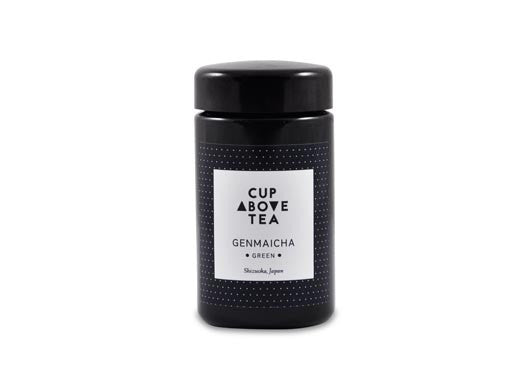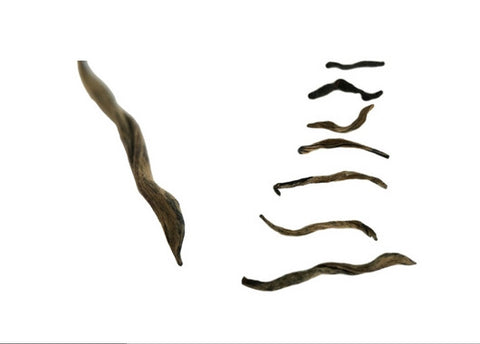Genmaicha - green tea
$3.95

| Style | Green Tea | |
| Origin | Nakayama Village near Fujieda City in Shizuoka, Japan | |
| Season | Spring 13 (lightly aged) | |
| Altitude | 350m | |
| Batch | TJG1 | |
| Plant | Camellia sinensis sinensis, Yabukita varietal, blended with Japanese sweet mochi brown rice | |
| Tea Master | Master Toshiaki Kinezuka |
This organic green tea is paired with 100% Japanese grown sweet mochi rice. The mineral, salty flavours are balanced by a nuttiness and top notes of buttered popcorn. An unusually high quality and classic Japanese tea.

 |
80 degrees Celsius | |
 |
1 x tablespoon (3 grams) | |
 |
150 ml water (small tea cup) |
|
 |
Infuse for 1 to 2 minutes |
The Stories We Drink
|
Toshiaki, his wife Kazue and their children Ayumi, Tamiko and Kazuki run this small organic tea farm producing a variety of quality teas throughout the year. During the winter, when their tea plants are dormant, the family shifts focus to their mikan (tangerine) trees that fruit during the cold season. The Kinezuka’s organic garden is in the mountains in the small village of Nakayama, near the city of Fujieda. Toshiaki San is renowned in Japan for his commitment to natural, organic farming techniques. Organic farming is rare in Japan and the Kinezuka’s approach to pesticide free agriculture has inspired other farmers in their village to adopt the same principles. Over 40 years, these principles have resulted in an incredible local ecosystem characterised by exceptional soil, farmer cooperation and family collaboration, impressively, they have created a macro environment in the village that makes the need for pesticides obsolete. Genmaicha is a blend of Japanese green tea and roasted brown rice. While it’s not pure tea (because of the blended roasted rice), the Japanese, and indeed the wider tea community, consider it a staple green tea deserving of its place alongside the famous senchas, gyokuros, houjichas and matchas of this incredible tea growing country. Genmaicha was originally considered the ‘tea of the people’. It’s generally accepted that genmaicha was invented hundreds of years ago when tea was gaining popularity in Japan, but was very expensive making it an unaffordable luxury for many working the land. To help make the expensive leaves last a little longer an inventive farmer added some toasted rice. This meant less tea leaves were needed for each pot and the tea supply was stretched out. Pleasingly, the flavour was pleasant and it quickly caught on and remained popular as tea prices settled. You can learn more about the Kinezukas and genmaicha here. |
|
Craftsmanship
There are plenty of inferior genmaichas on the market. Growers often use low quality late harvest leaves and rely on strong roasted rice to mask the off flavours. Like tea, there are also various grades of roasted rice.The Kinezukas use superior tea leaves grown on their all-natural, organic farm and they only use 100% Japanese grown sweet mochi rice.
This rice is considered the highest quality and most traditionally true toasted rice for genmaicha. Premium genmaicha has become increasingly in vogue thanks to its palate cleansing properties and ability to enhance the flavour of fine foods.
 |
Plucking: Spring harvest sencha forms the base of this genmaicha, providing a more complex taste with lots of flavour depth. The leaves are grown in full sun and harvested in early spring. This harvest is considered the finest of the year in terms of quality, freshness and flavour. |
|
 |
Steaming: Japanese teas are unique from all other green teas because they are steamed immediately after harvest. Steaming stops the leaves from oxidising and turning brown. This means the natural green colour, fresh aroma and nutritional components are retained. The length of the steaming process varies and this largely determines the flavour characteristics and colour of the tea. | |
 |
Rolling: Rolling gives the leaf its characteristic needle shape. There are several stages of rolling. |
|
 |
Drying: The leaves are dried to remove remaining traces of moisture and to lock in the flavour. They are now ready for sorting and blending. |
|
 |
Blending: The Kinezuka’s add sweet mochi rice to the sencha. Like tea, the mochi rice harvest varies from season to season. Only the most suitable harvest is selected. The rice is roasted which causes some of the kernels to pop. These popped kernels are white (like popcorn pieces), while the unopened kernels are a yellow and brown colour. The kernels are blended by hand with the high quality sencha to produce a sophisticated genmaicha blend. |













